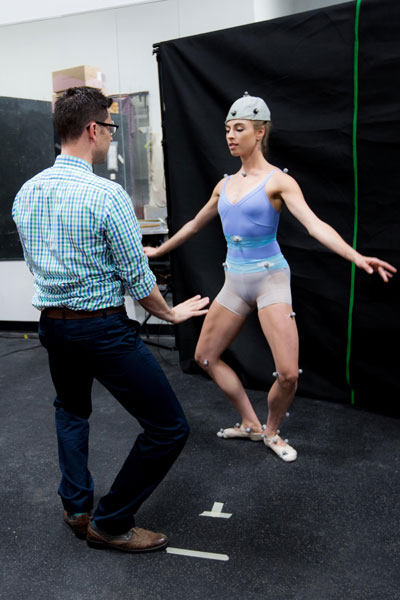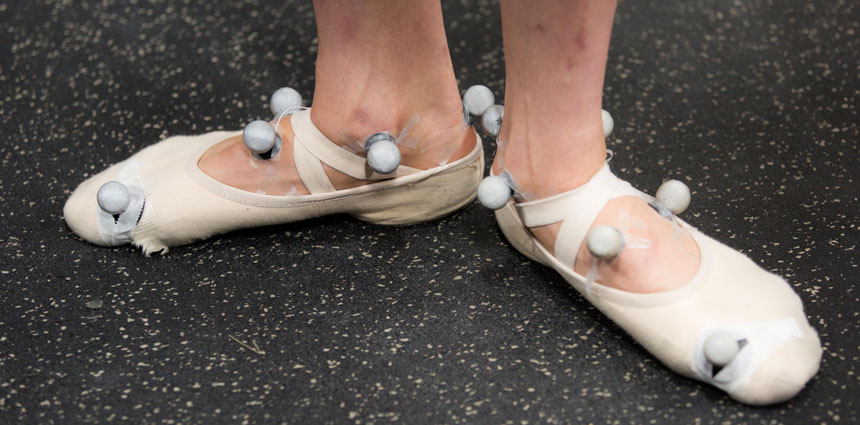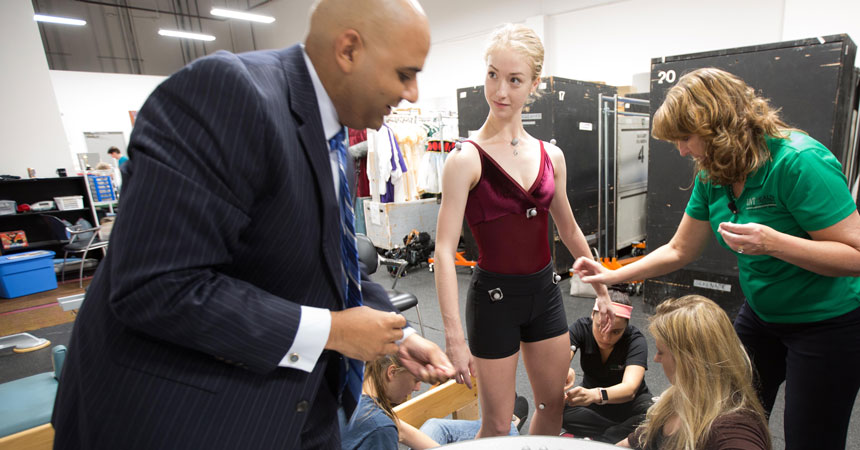The doctors and the dancers
By Jan Jarvis
During a break from rehearsals for “Cinderella,” Celeste Gaiera stood still as 37 reflective markers were taped to her torso, legs and head.
Then, looking more like a sci-fi character than a ballet dancer, she practiced plies – a familiar ballet step – as six motion capture cameras recorded her every move.
The experience – part of a UNT Health Science Center research project – was a little unnerving for the Texas Ballet Theater dancer, but the promise of possibly preventing injuries made it more than worthwhile.
“It will be so exciting to see if there are things I can do to avoid being hurt,” she said. “I know I put my body through so much wear and tear.”
Injuries are a job hazard for ballet dancers, but an interdisciplinary team of UNTHSC physicians, physical therapists and researchers are trying to change that using motion capture technology. The innovative collaboration between the graduate university and the theater company makes it possible to identify movements that over time can lead to tendonitis, fractures and other injuries, said Sajid Surve, DO, Associate Professor Family Medicine and Co-Director of the UNT Texas Center for Performing Arts Health.
Instead of rehabilitating an injury, the goal is to prevent one.
“If we can predict which ballet dancers are going to get hurt, we can perform interventions that will makes them more stable,” Dr. Surve said.
In the world of ballet, stability is everything. But over the years, all those leaps and lunges can give way to fatigue and injuries. Studies have shown 76 percent of dancers suffer injuries, most often caused by overuse.
“What makes a professional dancer look so good is their incredible stability,” Dr. Surve said. “When they move their arms and legs in space, the rest of their body is still, and they have complete control. They’re like statues.”
To capture the dancers’ as they practice, UNTHSC researchers are taking a mobile version of the university’s Human Movement Performance Lab to the Texas Ballet Theater. Three times during the season, they’ll record dancers performing the same movements and observe the changes that occur, said Rita Patterson, PhD, Professor and Director of Research in the Department of Manipulative Medicine.
“If we see them doing something that is not proper form, we’ll tell them,” Dr. Patterson said. “We could also, based on their posture, tell them that they’re about to injure themselves.”
During a recent rehearsal break, five male and five female dancers took turns having reflectors attached to specific bony landmarks, said project lead Nathan Hershberger, DO, a former professional dancer and a resident in Family Medicine/Osteopathic Neuromusculoskeletal Medicine at Medical City Fort Worth.

“The dancers were then recorded with 3D motion capture technology, exactly the same as what was used in the movie ‘Avatar,’” Dr. Hershberger said. “The long-term goal is to use this technology to recognize movement that would be considered pathological, and find ways to intervene to help prevent injury. That could, in theory, help to lengthen a dancer’s already short career.”
As the dancer moves, an enormous volume of data is transferred to the computer, where the dancers appear as stick figures on the screen. Each camera records 120 frames per second, or 7,200 frames per minute, Dr. Patterson said.
All those frames should add up to one of the most accurate pictures of what happens to the body when it is subjected to months of pounding and pressure.
“Dancers are particularly vulnerable to injuries because they tend to perform through the pain, both because they are so passionate about their art and because the show must go on,” Dr. Patterson said. “To achieve the appearance of perfection, they compensate for their injuries.”
Since the dancers are recorded over nine months, the research team should get a rare view of how the body compensates for damage over time.
“In August they’re fresh and perfect.” Dr. Patterson said. “But by December they may be exhausted and more vulnerable to injury.”






Social media